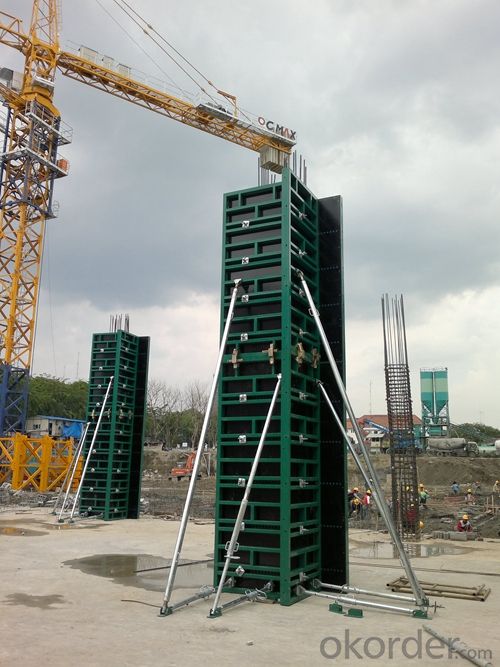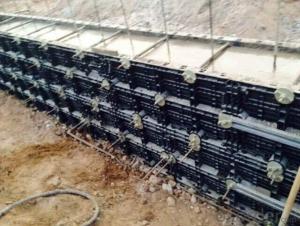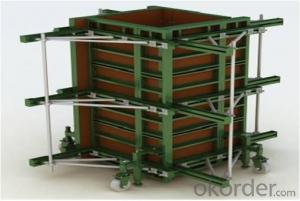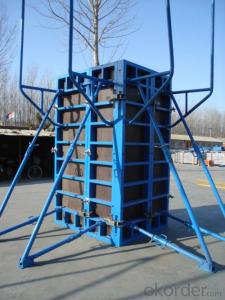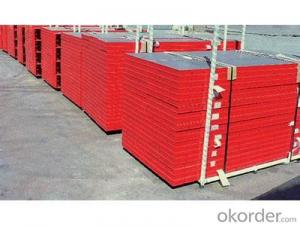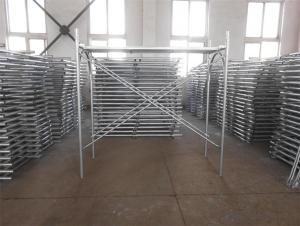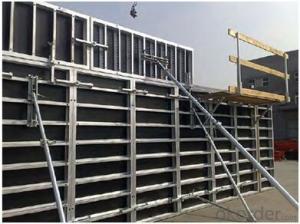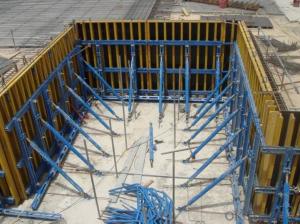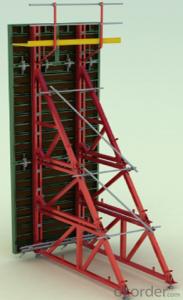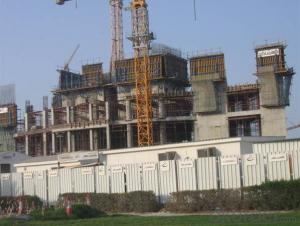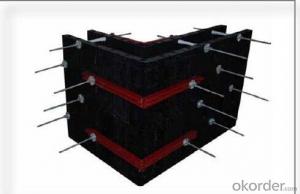CNBM STEEL FRAMED FORMWORK FOR CONSTRUCTIONS
- Loading Port:
- Shanghai
- Payment Terms:
- TT OR LC
- Min Order Qty:
- 1 m²
- Supply Capability:
- 100000 m²/month
OKorder Service Pledge
OKorder Financial Service
You Might Also Like
1. Structure of 120 Steel Framed Formwork Description
Single-side bracket is a kind of formwork for the concrete pouring of single-side wall. The construction is easy and fast. The components have good standard performance and versatility. The pouring height is adjustable, the maximum height of a single pouring is 8.9m.The formwork is always used in the concrete pouring of basement, subway, Sewage treatment factory and so on. The waterproof of the finished wall is excellent
2. Main Features of 120 Steel Framed Formwork
-easy to assemble
-simple structure.
-and convenient for transportation
-convenient for storage.
3. 120 Steel Framed Formwork Images
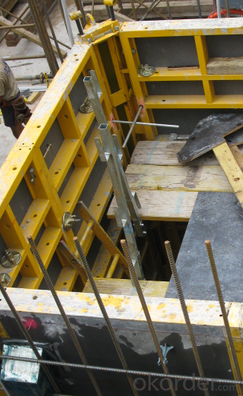
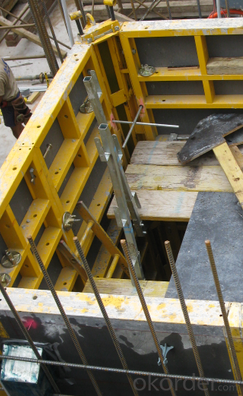
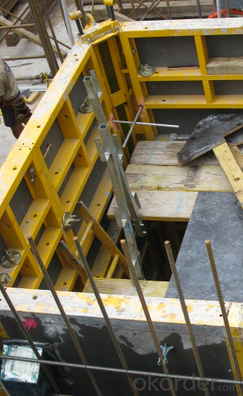
4. Single-side Steel Framed Formwork Specifications
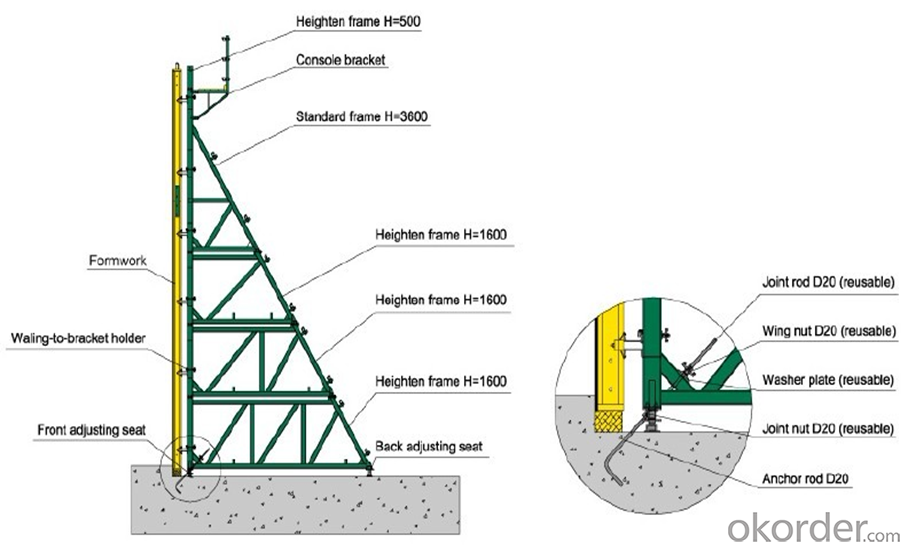
5.FAQ of 120 Steel Framed Formwork
1) What can we do for you?
.We can ensure the quality of the 120 steel framed formwork and avoid extra expenses for customers.
.We can provide you the professional technical team.
.We can provide professional building proposal for your project.
. Please feel free to customize.
2) What promises can be done by us?
. If interested in single side steel framed formwork, please feel free to write us for any QUOTE.
. If need any technical and building assistance, we could provide on-site professional staff for instruction.
. Please DO check goods when courier knocks your door and contact us asap if any issueS.
3) What about of our after-sale service?
. Response will be carried out in 24hours after receiving any complain or request.
. Single side steel framed formwork cost can be refund after order is confirmed.
. If the products are not based on the requirements, there will be the relevant compensations made for you.
4) What about the package and shipping time?
.Packing: wood package and
.Shipping: by sea
Shipping time: Normally small orders, it just1week business days to arrive your hand; When comes to the customs declaration, it may need 2 weeks.
- Q: Can steel frame formwork be used for tunnel construction?
- Indeed, tunnel construction can utilize steel frame formwork. This versatile and long-lasting system is frequently employed in diverse construction endeavors, including tunnel construction. It offers a robust and sturdy structure for concrete pouring, guaranteeing precise and accurate formation of tunnel walls and ceilings. The assembly and disassembly of steel frame formwork are effortless, enabling efficient and economical tunnel construction. Moreover, its resistance to environmental factors, like moisture and temperature fluctuations, renders it ideal for underground settings.
- Q: What are the common challenges faced when using steel frame formwork?
- There are several common challenges that can be faced when using steel frame formwork in construction projects. One challenge is the weight of the steel frame itself. Steel is a heavy material, which can make it difficult to handle and maneuver on the construction site. This can slow down the construction process and require additional labor and equipment to move and position the formwork. Another challenge is the complexity of assembling and disassembling the steel formwork. Steel frames often require a precise and intricate assembly process, which can be time-consuming and require skilled workers. Disassembling the formwork can also be challenging, as it may require careful dismantling to avoid damage to the frame or other components. Additionally, steel frame formwork can be more expensive compared to other types of formwork, such as wood or aluminum. The cost of purchasing or renting steel formwork can be a significant investment for construction projects, especially for smaller or budget-constrained projects. This cost factor needs to be carefully considered when choosing the formwork material. Furthermore, steel frame formwork may not be suitable for all construction projects. The rigid nature of steel frames makes them less adaptable to irregular shapes or complex architectural designs. If a project requires a high level of customization or intricate formwork structures, steel frames may not be the most efficient option. Lastly, steel frame formwork requires regular maintenance to ensure its durability and longevity. Rust and corrosion can occur over time, especially in harsh environmental conditions or when exposed to moisture. Regular inspections and maintenance are necessary to identify and address any issues promptly, which can add to the overall project cost and time. Despite these challenges, steel frame formwork offers several advantages, such as high strength and durability, reusability, and suitability for large-scale construction projects. By addressing these challenges through proper planning, skilled labor, and regular maintenance, the benefits of using steel frame formwork can outweigh the difficulties.
- Q: Can steel frame formwork be used for both straight and curved concrete elements?
- Indeed, both straight and curved concrete elements can be constructed using steel frame formwork. The adaptability of steel frame formwork allows for effortless modification and molding to accommodate diverse angles and curves. The robustness and stability of steel make it an ideal material for fabricating formwork capable of enduring the pressure and forces exerted by the concrete throughout the pouring and curing stages. Moreover, steel formwork can be reused, presenting a cost-effective option for both straight and curved concrete elements.
- Q: Can steel frame formwork be used for tall structures?
- Yes, steel frame formwork can be used for tall structures. Steel frame formwork is known for its strength and durability, making it suitable for constructing tall buildings. Its rigid structure allows for precise and efficient concrete pouring, ensuring the stability and integrity of the structure. Additionally, steel frame formwork can be easily adjusted and reused, making it a cost-effective solution for tall construction projects.
- Q: Can steel frame formwork be used for airport and transportation infrastructure construction?
- Yes, steel frame formwork can be used for airport and transportation infrastructure construction. Steel frame formwork offers high strength and durability, making it suitable for large-scale projects like airports and transportation infrastructure. It provides a stable and rigid structure for pouring concrete, ensuring the accuracy and quality of the construction. Additionally, steel frame formwork can be easily assembled, disassembled, and reused, making it cost-effective and efficient for such complex construction projects.
- Q: What are the different types of accessories used with steel frame formwork?
- Steel frame formwork systems commonly utilize various accessories to enhance efficiency and effectiveness, as well as provide additional support and stability to the structure being formed. One frequently used accessory with steel frame formwork is the form tie. Form ties are employed to prevent the spreading apart of formwork panels under concrete pressure, effectively holding them together. Typically constructed from steel, form ties are available in different lengths to accommodate varying formwork heights. Another significant accessory is the formwork clamp, which securely fastens formwork panels to the steel frame, ensuring they remain in place during concrete pouring and curing. Formwork clamps come in different sizes and designs to suit various formwork configurations. Strong and durable formwork props or scaffolding are also necessary for supporting the weight of formwork panels and freshly poured concrete in steel formwork. These adjustable props provide stability to the formwork system and are typically made of steel, varying in size and load-bearing capacities. Additional accessories used in steel frame formwork include corner connectors for connecting formwork panels at 90-degree angles, and formwork release agents to prevent concrete from adhering to the formwork surface. Furthermore, accessories like formwork liners can be utilized to create different surface finishes on the concrete, while chamfer strips can produce beveled edges and smooth transitions between different formwork sections. In conclusion, the diverse range of accessories employed in steel frame formwork is aimed at delivering stability, support, and ease of use, ultimately ensuring the efficient and effective function of the formwork system during the concrete pouring process.
- Q: Can steel frame formwork be used for curved structures?
- Indeed, curved structures can be constructed using steel frame formwork. The versatility of steel frame formwork allows for effortless adjustments or modifications to form curved or intricate shapes. This is accomplished by implementing flexible plywood or metal sheets that can be flexed or contoured to conform to the desired curve. Moreover, steel frame formwork offers exceptional durability and steadfastness, rendering it suitable for erecting both linear and curved structures.
- Q: How does steel frame formwork contribute to better concrete compaction in congested areas?
- The efficient design and rigid structure of steel frame formwork greatly enhance concrete compaction in congested areas. This construction technique utilizes steel panels, beams, and props to create a strong framework for pouring concrete. In areas with limited space and restricted maneuverability, steel frame formwork proves to be extremely advantageous. Its compact design allows for easy assembly, dismantling, and movement around the site, minimizing disruptions and maximizing the use of available space. By providing a stable platform for concrete placement, it ensures proper pouring and compaction, even in tight or complex areas. The precise alignment and positioning of the formwork, made possible by its rigid structure, guarantee accurate pouring and consistent results. This eliminates the risk of voids or weak spots in the concrete, resulting in a more durable structure of higher quality. Additionally, the steel framework provides excellent support for the weight of the concrete, preventing deformations or misalignment during the pouring and compaction process. Moreover, steel frame formwork allows for the integration of various compaction techniques. Vibrators can be easily attached to the formwork, enabling efficient and uniform compaction of the concrete. This helps achieve optimal concrete density, reducing the risk of segregation and improving the overall strength and durability of the structure. Furthermore, the use of steel frame formwork reduces the need for excessive labor and manual compaction, which can be challenging in congested areas. The formwork acts as a guide, ensuring correct placement and compaction of the concrete without extensive manual intervention. This saves time and effort, while also minimizing the risk of human error and ensuring a consistent and reliable compaction process. In conclusion, steel frame formwork significantly enhances concrete compaction in congested areas by providing a stable and rigid structure, enabling accurate alignment and positioning, integrating various compaction techniques, and reducing the need for excessive manual labor. Its efficient design and compact nature make it an ideal choice for construction projects in congested areas, ensuring successful and high-quality completion of concrete works.
- Q: How does steel frame formwork help in achieving accurate concrete leveling?
- Steel frame formwork helps in achieving accurate concrete leveling by providing a rigid and stable structure that holds the concrete in place during pouring and curing. The steel frame ensures that the formwork remains in position and does not deform or shift, allowing the concrete to settle evenly and maintain a consistent level. This helps to eliminate any potential inconsistencies or discrepancies in the concrete surface, resulting in a more precise and level finish.
Send your message to us
CNBM STEEL FRAMED FORMWORK FOR CONSTRUCTIONS
- Loading Port:
- Shanghai
- Payment Terms:
- TT OR LC
- Min Order Qty:
- 1 m²
- Supply Capability:
- 100000 m²/month
OKorder Service Pledge
OKorder Financial Service
Similar products
Hot products
Hot Searches



